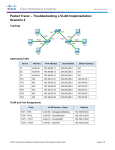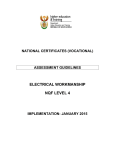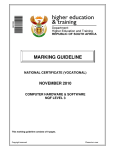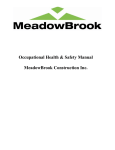Download ISAT ARM L3 2014-15
Transcript
NATIONAL CERTIFICATE (VOCATIONAL) NQF LEVEL 3 INTEGRATED SUMMATIVE ASSESSMENT TASK SUBJECT ISAT: AUTOMOTIVE REPAIR AND MAINTENANCE 2014-2015 This document consists of 11 pages. 1 SECTION 1: INTRODUCTION 1. Practical purpose and value of the ISAT to the workplace. This ISAT is a practical task that draws on the student’s cumulative learning throughout the year and being acquainted with the needs of the industry. A checklist and a rubric are used as a tool to evaluate student’s performance. The focus of this ISAT is not only to assess whether students can successfully perform each specific activity in the task, but also to determine whether they can integrate and apply their knowledge and skills in performing a world-of-work task. The purpose of the ISAT is also to afford students the opportunity to demonstrate creativity, innovation and problem solving skills. The competence of the student is measured against the assessment criteria prescribed in the Subject and the Assessment Guidelines of 2014. This ISAT emanates from Topic 12 of the Level 3 Automotive Repair and Maintenance curriculum of 2014. The ISAT should take place in a real life work-based situation and must be executed under strict exam conditions. The ISAT consist of activities which can be done in stages throughout the year. 2 2. Scope of the ISAT Topic 12: Maintenance and Repair of Driveline and Related Components. Subject Outcome: 12.1 Functioning and Operation of a 5 Speed Manual gearbox Learning Outcomes: Explain different types of gears in a gearbox. Explain the functioning of a gearbox. Explain the relationship between gear ratio and torque. Explain the different types of gear lever arrangement. Describe the different types of gearboxes. Explain the power flow through different gears in a gearbox. Subject Outcome: 12.2 Perform Repairs on a Front or Rear Wheel drive 5 Speed Manual Gearbox. Learning Outcomes: Perform safety procedures when working on gearboxes. Use a manual to acquire the manufacture’s specifications. Dismantle (strip) the gearbox and inspect all relevant parts for wear. Compile and submit a condition report. Replace worn or damage parts. Assemble the gearbox according to manufacturer’s specifications. Complete relevant documentation to record repairs. 3 3. Task Descriptions Activity ONE r e q u i r e s that the student must answer all 8 theoretical questions which total 30 marks and the duration is 30 minutes. Activity TWO requires the student t o dismantle and assemble the g e a r b o x . This activity is worth 130 marks and must be completed within 5 hours 30 minutes. This activity must be carried out on a 5 speed front or rear wheel drive gearbox. The student must be able to complete all the 8 sub-tasks in the prescribed time. The total duration to complete both activities is 6 h o u r s . The time duration includes the preparing and restoring of the work area. Parts that are serviceable can be used again. After completion of the task, the student needs to demonstrate the selection of all the gears including the reverse gear. This is to test the operation of the gearbox and to ensure that all gears can be selected. This test must be conducted under the supervision of the assessor. 4. ISAT overview This ISAT consists of TWO activities. The first activity consists of EIGHT theoretical questions which have a total of 30 marks. The second activity consists of EIGHT sub–tasks which add up to a total 130 marks. Task Activity 1 Functioning and Operation of a 5 speed Manual gearbox (front or rear wheel drive). 2 Dismantle and Assemble a 5 speed Manual gearbox. TOTAL 4 Time Allocation 30 min Mark Allocation 30 5 hours 30 min 130 6 hours 160 5. Resource requirements 5.1 INFRASTRUCTURE 5.2 MATERIALS / CONSUMABLES 5.1.1 A workshop that complies with all safety regulations. 5.1.2 A well equipped workshop with the appropriate equipment. 5.2.1 Cleaning materials. 5.2.2 Container in which to drain the lubricant. 5.2.3 Waste bins and brooms. 5.2.4 Waste cloth. 5.2.5 Clipboard and suitable writing material to write a report. 5.3 PARTS (SAME PARTS CAN BE USED IF IT IS IN A GOOD WORKING CONDITION) 5.3.1 Recommended gearbox oil. 5.3.2 Oil seals. 5.3.3 Gaskets. 5.4 TOOLS/ EQUIPMENT 5.4.1 Appropriate hand tools. 5.4.2 Workshop manuals. 5.4.3 Parts Tray. 5.5.1 Dial gauge. 5.5.2 Feeler gauge. 5.5.3 Torque wrench. 5.5.4 Pre-load gauge or Pull scale. 5.5 SPECIAL EQUIPMENT 6. Assessment Tools • A separate Marking Guideline is provided for activity ONE which the assessor should use to assess the student’s performance in the task. This Marking Guideline must NOT be handed to students. • In Task TWO, the student’s performance should be measured using the Rubric and a Checklist provided. These assessment tools should NOT be made available to the students before or during the task. 5 SECTION 2: INSTRUCTIONS TO ASSESSOR 1. Study the ISAT as described in SECTION 1. 2. Arrange a pre-assessment interview with the students to inform them of the date(s), time(s) and venue of the ISAT. Also inform them about the requirements and conditions for the ISAT. Students also need to be aware of what is expected of them during the ISAT. Students need to be made aware that the ISAT will be conducted under strict examination conditions. 3. ALL safety practices and procedures must be adhered to. 4. The assessment centre should comply with the assessment standards. 5. All equipment used must be good, clean and in a safe working order. 6. All tools, vehicle data and safety equipment should be readily available to the student before and during assessment. 7. Students must protect themselves with the necessary Personal Protective Equipment (PPE). No student will be allowed to start the ISAT without PPE. 8. All waste must be discarded according to the Occupational Health and Safety Act (OHSA). 9. The assessor must intervene to protect the students from any unsafe act that could lead to injury and damage to property. 10. The assessor should monitor the students’ conduct during the assessment. It is important that the assessor must ensure that the ISAT be carried out according to the examination rules. 11. ALL documents must be signed by the student and the assessor. 12. The duration of the task is 6 hours (5hours 30 min + 30 min) which is divided according to the instruction sheet to the student for the different activities. 13. SECTION 3 contains the Assessment Tool for Task 2 which is a Rubric. The Rubric should be handed to students prior the conduct of the ISAT. See the separate Marking Guideline for possible responses to Task 1 and the checklist for Task 2. 14. A separate Marking Guideline (checklist) is provided which the assessor should use in conjunction with the Rubric in order to assess the student’s performance. This Marking Guideline must NOT be handed to students before conducting the ISAT. 6 15. To calculate the final mark you need to add the scores of each sub-task in the rubric to the theoretical questions. The total marks need to be converted to a percentage. The total marks are 160 (30+130) for the complete ISAT. 16. Students must be given the “Instruction to Students” (contains an instruction sheet) which describes to them what needs to be done. 17. Student performance in the ISAT must conclude with a record of the student’s performance as provided for in SECTION 4. 7 SECTION 3: ASSESSMENT TOOLS TASK 1 – see Marking Guideline provided in a separate document TASK 2 – Rubric (also see CHECKLIST in Marking Guideline provided in a separate document 1 Assessment Criteria Prepare the work area according to work site procedures. (Max 8 marks) 2 Use a manual to identify the manufactures specifications. (Max 9 marks) Level 4 Outstanding Level 3 Highly Competent Level 2 Competent Level 1 Not Yet Competent All of the work site procedures were followed correctly. Most of the work site procedures were followed correctly. Adequate work site procedures were followed correctly. Little or no work site procedures were followed. (8 marks) (5-7 marks) (4 marks) (0-3 marks) All relevant information in service manual was used. (8-9 marks) Most of the service manual was used. (5-7 marks) 8 Sufficient service manual information used. (4½ marks) Service manual information not used. (0 -4 marks) Marks scored Criteria no Perform Repairs on 5 Speed Manual Gearboxes. 3 4 5 6 Dis-assemble the gearbox and inspect all relevant parts for wear. Outstanding performance to inspect and disassemble gearbox was performed. High level performance to inspect and disassemble gearbox was performed. An adequate performance to inspect and disassemble gearbox was performed. Little or no performance to inspect and disassemble gearbox was performed. (Max 20 marks) Compile and submit a condition report (16 -20marks) All of the correct steps were followed. (11-15 marks) Most of the correct steps were followed. (10marks) Sufficient steps were followed. (0-9 marks) None of the correct steps were followed. (Max 25 marks) Replace worn or damage parts (19-25 marks) All the correct steps to replace the parts were followed. (13-18 marks) Most of the correct steps to replace the parts were followed. (12½ marks) Sufficient steps to replace parts were followed. (0-12 mark) None of the correct steps to replace parts were followed. (13-18 marks) Most of the correct steps to assemble the parts were followed. (12½ marks) Sufficient steps to assemble the parts were followed. (0-12 marks) None of the correct steps were followed to assemble the parts. (13-18 marks) (12½ marks) (0-12 marks) (Max 25 marks) Assemble the gearbox according to manufacture specifications (Max 25 marks) (19-25 marks) All the correct steps to assemble the parts were followed. (19-25 marks) 9 7 8 Complete relevant documentation and record repairs All the correct steps to complete documents were followed. Most of the correct steps to complete documents were followed. Sufficient steps to complete documents were followed. None of the correct steps were followed to complete documents. (Max 8 marks) Restore work area (8 marks) All the correct steps to restore work area were followed. (5-7 marks) Most of the correct steps to restore work area were followed. (4 marks) Sufficient steps to restore work area were followed. (9-10 marks) (6-8 marks) (5 marks) (0-3 marks) None of the correct steps were followed to restore work area. (0-4 marks) (Max 10 marks) 10 SECTION 4: RECORD OF PERFORMANCE INTEGRATED SUMMATIVE ASSESSMENT TASK AUTOMOTIVE REPAIR AND MAINTENANCE LEVEL 3 College: Campus: Student’s Surname and First Name/s: Student’s ID Number: Assessor’s Surname and Initials: Date of conclusion of assessment: ASSESSMENT GRID MARK ALLOCATION TASK: 1 Functioning and Operation of a 5 Speed Manual gearbox TASK: 2 Dismantle and Assemble a 5 Speed Manual gearbox TOTAL PERCENTAGE ACHIEVED 30 130 160 % 5-Point Achievement Rating Scale 5 4 3 2 (80- 100%) (70-79%) (50-69%) (40-49%) Rating Code 5 4 3 2 1 STUDENT’S MARK SCORED Competency Level Indicators Rating Outstanding Highly Competent Competent Not Yet Competent Not Achieved Student’s competence level: Student’s signature: Lecturer’s signature: Date and Time of Assessment: 11 Marks % 80 – 100 % 70 –79 % 50 – 69 % 40 –49 % 0 – 39% 1 (0-39%) NATIONAL CERTIFICATE (VOCATIONAL) NQF LEVEL 3 INSTRUCTIONS TO STUDENTS SUBJECT ISAT: AUTOMOTIVE REPAIR AND MAINTENANCE LEVEL 3 2014-2015 This document consists of 4 pages. 1 INSTRUCTIONS TO STUDENTS This ISAT consists of a practical (130 marks) and theoretical (30 marks) task. This task tests your ability to apply the knowledge and skills acquired in the subject Automotive Repair and Maintenance. The work required of you in this Integrated Summative Assessment Task (ISAT) is an important and compulsory task that adds up to a total of 160 marks. This task will be carried out under examination conditions. You are required to: 1. Ensure that you are punctual. 2. Ensure that you are wearing suitable Personal Protective Equipment (PPE). 3. Follow all safety precautions wh e n carrying out the task. (Note: You will be prevented from continuing the task unless you rectify the mistakes as advised by the lecturer). REMEMBER SAFETY FIRST. 4. Identify and select appropriate the requirements of the task. hand tools and equipment to meet 5. Consult a service manual and adhere to manufacturer’s specifications. 6. Ensure that you comply with ALL the instructions of the assessor. 7. Conduct all tasks according to safe working workshop procedures. 8. Clean the work area and discard waste Occupational Health and Safety Act (OHSA). material according to the 9. Your performance in each of the activities will be assessed by means of a rubric. The lecturer will use the rubric in conjunction with the checklist provided to mark your ISAT. 2 10. Write and submit a condition report on the work done for all sub-tasks to assist you to arrive at a conclusion about the condition of the gearbox. 10.1. You need to mention in your report what corrective action needs to be taken to solve the problems. 10.2. This report should also include findings and recommendations. 10.3. You also need to complete relevant documentation to record repairs. QUESTIONS FOR TASK 1 1. Name the TWO common types of gears in a gearbox and explain TWO advantages and TWO disadvantages of each. (6) 2. Explain the relationship between gear ratio and torque. (2) 3. The first gear ratio is normally 3,8 : 1 Calculate the fifth gear ratio if a driving gear rotates at a speed of 3750 rpm and a driven gear rotates at a speed of 5000 rpm. (3) 4. Name FIVE functions of a gearbox. (5) 5. Explain the power flow in a gearbox when the reverse gear is selected. (6) 6. Which gear is responsible for changing the direction (reverse) of rotation in the gearbox? (1) 7. Describe the difference between a sliding mesh and a Constant mesh gearbox. (2) 8. Explain the operation of a synchromesh unit when 3rd gear is selected. (5) TOTAL 3 [30] INSTRUCTIONS FOR TASK 2 Dismantle and Assemble a 5 speed Manual Gearbox Sub task 1 2 3 4 5 6 7 8 Activity 2 Time Allocation Prepare the work area and follow safety procedures f o r wo r k i n g o n g e a r b o xe s . Obtain the appropriate hand tools and equipment. Use a service manual to obtain manufacturer’s specifications. Mount the gearbox safely and remove the drain plug and drain the oil. Perform a visual inspection on the gearbox and do all the pre-checks. Remove bell housing, inspection cover and extension housing. Remove the main shaft, input and cluster gear. Dis-assemble the gearbox completely and lay out parts in a parts tray. Clean and examine the condition of the parts. Compile and submit a condition report on the parts and replace the faulty parts . Start to assemble the gears on the main shaft. Install cluster gear, main shaft, input shaft and all other parts and assemble the rest of the gearbox according to manufacture specifications. Operate the gear lever to test if all gears can be selected this include the reverse gear. Complete relevant documentation to record. Restoring Repairs the work area: Clean the tools and return it. Clean the special tools and equipment and return it to the store. TOTAL 4 Mark Allocation 20 min 8 24 min 9 52 min 20 63 min 25 63 min 25 63 min 25 20 min 8 25 min 10 330 min 130 NATIONAL CERTIFICATE (VOCATIONAL) NQF LEVEL 3 MARKING GUIDELINES SUBJECT ISAT: AUTOMOTIVE REPAIR AND MAINTENANCE 2014-2015 This document consists of 5 pages 1 TASK 1 Question 1 Spur Gear: (1) Advantages o Mechanical efficiency is high o Cheap to manufacture o Reduce side thrust (Any two responses) (2 X ½) Disadvantages o Gears are noisy o Requires considerable skill to change. (2 X ½) Helical Gear: (1) Advantages o Provide greater tooth contact o Operate quieter (2 X ½) Disadvantages o More expensive o Cannot slide easily into mesh (2 X ½) Question 2 Gear ratio is the speed of the input shaft to the speed of the output shaft. (1) Torque: A big gear will have a slow speed and a high torque and vice versa. (1) Question 3 Gear Ratio=Speed of driving gear/ Speed of Driven gear (1) Gear Ratio=3750 rpm/ 5000 rpm (1) Gear Ratio=0,75 : 1 (1) 2 Question 4 Provide permanent neutral (1) Allows vehicle to operate satisfactorily when climbing an incline (1) Enable the engine torque to increase (1) Provide a forward and reverse gear (1) Increase the leverage over the driving shaft. (1) Question 5 Power flows from the input shaft (1) Through the cluster gear (1) Reverse idler gear (1) Reverse gear (1) Synchro sleeve (1) Synchro hub (1) Main shaft (1) Max 6 Question 6 Reverse idler gear (1) Question 7 In a sliding mesh gearbox, the gears on the output shaft can slide from side to side in order to engage the gears on the lay shaft. (1) In a constant mesh gearbox, all the gears on the output shaft are constantly in mesh with their corresponding gears on the lay shaft. 3 (1) Question 8 When the driver shifts gears, the synchronizer sleeve slides on its splined hub towards the selected output gear. The synchro ring rubs on the side of the third gear cone. (1) Friction causes the speed of the gear, synchronizer and output shaft to eventually turn at the same speed. (1) When the speed of the three components is the same, the synchro-sleeve can slide completely over the synchro ring and over the dog teeth on the output gear. (1) This locks the output gear to the synchronizer hub and to the main shaft. (1) Torque is then transmitted to the output gear and the output shaft, to the drive shaft and the wheels. (1) TOTAL 4 [30] TASK 2 – Checklist for rubric Dismantle and Assemble a 5 speed Manuel gearbox 1 2 3 4 5 6 7 8 Prepare the work area. Obtain the appropriate hand tools and special tools. Obtain the correct equipment. Obtain a service manual Mount the gearbox and follow safety procedures Remove drain plug and drain oil. Perform a visual inspection on the gearbox. Do all the pre-checks. Remove following: Bell housing Inspection cover Extension housing. Remove the following : Main shaft Input Cluster gear. Dismantle the rest of the gearbox completely Lay out parts in a parts tray. Clean and examine the condition of the parts Prepare a condition report on the parts. Replace the faulty parts. Start to assemble the gears on the main shaft. Install the following: Cluster gear Main shaft Input shaft Assemble the rest of the gearbox. Operate the gear lever to see if all gears can be selected. Complete relevant documentation to record repairs that was done on the gearbox. Restoring the work area: Clean the work area and discard waste material Clean the tools and store it away. Clean the special tools and equipment and return it to the store. 5 2 3 3 3 3 3 3 7 3 3 4 5 5 5 5 1 4 5 20 5 5 5 5 5 3 5 4 3 3





























